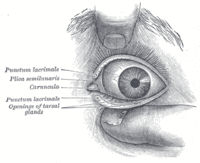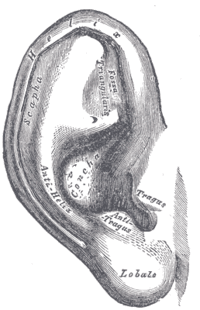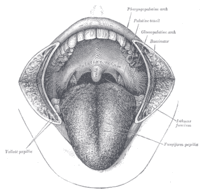Difference between revisions of "Sense" - New World Encyclopedia
Rick Swarts (talk | contribs) |
Rick Swarts (talk | contribs) |
||
| Line 1: | Line 1: | ||
{{Contracted}}{{Status}} | {{Contracted}}{{Status}} | ||
| − | Note: This is only a very rough draft, with notes that may be useful in developing the article. Please do not edit this article until the actual article is complete — i.e., when this notice is removed. You may add comments on what you would like to see included. [[User:Rick Swarts|Rick Swarts]] | + | Note: This is only a very rough draft, with notes that may be useful in developing the article. Please do not edit this article until the actual article is complete — i.e., when this notice is removed. You may add comments on what you would like to see included. [[User:Rick Swarts|Rick Swarts]] 15:26, 29 December 2005 (UTC) |
:''This article is about the senses of living organsims (vision, taste, etc.). | :''This article is about the senses of living organsims (vision, taste, etc.). | ||
| Line 6: | Line 6: | ||
Broadly defined, '''senses''' are the inherent mechanisms or faculties by which organisms receive information about their external or internal environment. That is, in general, a "sense" is a faculty by which stimuli from outside and inside the body are received. | Broadly defined, '''senses''' are the inherent mechanisms or faculties by which organisms receive information about their external or internal environment. That is, in general, a "sense" is a faculty by which stimuli from outside and inside the body are received. | ||
| − | As | + | As defined, this term includes both physiological methods of perception, involving reception of stimuli by sensory cells, and incorporal methods of perception, as in spiritual senses (see below). It also allows sense by microorganisms, such as signal transduction pathways that allow detection of nutrients, such as sugars, amino acides, and nitorgen sources. ''Geobacter metallireducens'', a common soid bacteria, apparently has a built-in sensor that allows it to locate iron and manganese oxides that serves as its food source. |
| − | + | As more narrowly defined for higher animals, a sense is considered a system involving sensory cells that respond to a specific kind of physical energy (both internal and external stimuli), which are converted into nerve impulses that travel to the brain (either a specialized area or specialized areas), where the signals are received and analyzed. | |
| − | |||
| − | |||
| − | |||
| − | |||
| − | |||
| − | |||
| − | |||
| − | |||
| − | As more narrowly | ||
Because there are differing definitions of a 'sense," there is no firm agreement among neurologists as to exactly how many senses there are. School children are routinely taught that there are five senses (sight, hearing, touch, smell, taste; a classification first devised by [[Aristotle]]), but it is generally agreed that there are at least nine different senses in humans, and a minimum of two more observed in other organisms. | Because there are differing definitions of a 'sense," there is no firm agreement among neurologists as to exactly how many senses there are. School children are routinely taught that there are five senses (sight, hearing, touch, smell, taste; a classification first devised by [[Aristotle]]), but it is generally agreed that there are at least nine different senses in humans, and a minimum of two more observed in other organisms. | ||
Revision as of 15:26, 29 December 2005
Note: This is only a very rough draft, with notes that may be useful in developing the article. Please do not edit this article until the actual article is complete — i.e., when this notice is removed. You may add comments on what you would like to see included. Rick Swarts 15:26, 29 December 2005 (UTC)
- This article is about the senses of living organsims (vision, taste, etc.).
Broadly defined, senses are the inherent mechanisms or faculties by which organisms receive information about their external or internal environment. That is, in general, a "sense" is a faculty by which stimuli from outside and inside the body are received.
As defined, this term includes both physiological methods of perception, involving reception of stimuli by sensory cells, and incorporal methods of perception, as in spiritual senses (see below). It also allows sense by microorganisms, such as signal transduction pathways that allow detection of nutrients, such as sugars, amino acides, and nitorgen sources. Geobacter metallireducens, a common soid bacteria, apparently has a built-in sensor that allows it to locate iron and manganese oxides that serves as its food source.
As more narrowly defined for higher animals, a sense is considered a system involving sensory cells that respond to a specific kind of physical energy (both internal and external stimuli), which are converted into nerve impulses that travel to the brain (either a specialized area or specialized areas), where the signals are received and analyzed.
Because there are differing definitions of a 'sense," there is no firm agreement among neurologists as to exactly how many senses there are. School children are routinely taught that there are five senses (sight, hearing, touch, smell, taste; a classification first devised by Aristotle), but it is generally agreed that there are at least nine different senses in humans, and a minimum of two more observed in other organisms.
The senses and their operation, classification, and theory are overlapping topics studied by a variety of fields, most notably neuroscience, cognitive psychology (or cognitive science), and philosophy of perception.
List of Human senses
Using this definition several senses can be identified.
Based on this outline and depending on the chosen method of classification, somewhere between 9 and 21 human senses have been identified. In addition, there are some other candidate physiological experiences which may or may not fall within the above classification (for example the sensory awareness of hunger and thirst). Finally, some individuals report synesthesia, the "crossing-over" of one sense to another, or even of senses associated with certain pure concepts. For example, the letter "A" may appear "black," certain notes may seem "orange" or "blue," and so forth.
Special senses
Sight or vision describes the ability to detect electromagnetic energy within the visible range (light) by the eye and the brain to interpret the image as "sight." There is disagreement as to whether this constitutes one, two or even three distinct senses. Neuroanatomists generally regard it as two senses, given that different receptors are responsible for the perception of colour (the frequency of photons of light) and brightness (amplitude/intensity - number of photons of light). Some argue that the perception of depth also constitutes a sense, but it is generally regarded that this is really a cognitive (that is, post-sensory) function of brain to interpret sensory input to derive new information.
Hearing or audition is the sense of sound perception and results from tiny hair fibres in the inner ear detecting the motion of a membrane which vibrates in response to changes in the pressure exerted by atmospheric particles within (at best) a range of 9 to 20000 Hz, however this changes for each individual. Sound can also be detected as vibrations conducted through the body by tactition. Lower and higher frequencies than can be heard are detected this way only.
Taste or gustation is one of the two main "chemical" senses. It is well-known that there are at least four types of taste "bud" (receptor) on the tongue and hence, as should now be expected, there are anatomists who argue that these in fact constitute four or more different senses, given that each receptor conveys information to a slightly different region of the brain.
The four well-known receptors detect sweet, salt, sour, and bitter, although the receptors for sweet and bitter have not been conclusively identified. A fifth receptor, for a sensation called umami, was first theorised in 1908 and its existence confirmed in 2000 (see [1]). The umami receptor detects the amino acid glutamate, a flavor commonly found in meat, and in artificial flavourings such as monosodium glutamate.
Smell or olfaction is the other "chemical" sense. Unlike taste, there are hundreds of olfactory receptors, each binding to a particular molecular feature, according to current theory. The combination of features of the odor molecule makes up what we perceive as the molecule's smell. In the brain, olfaction is processed by the olfactory system. Olfactory receptor neurons in the nose differ from most other neurons in that they die and regenerate on a regular basis.
If the different taste-senses are not regarded as separate senses one may argue that Taste and Smell should likewise be grouped together as one sense.
Somatic senses
Touch or tactition is the sense of pressure perception, generally in the skin. There are a variety of pressure receptors that respond to variations in pressure (firm, brushing, sustained, etc).
Thermoception is the sense of heat and the absence of heat (cold), also by the skin and including internal skin passages. There is some disagreement about how many senses this actually represents - the thermoceptors in the skin are quite different from the homeostatic thermoceptors which provide feedback on internal body temperature.
Nociception is the perception of pain. It can be classified as from one to three senses, depending on the classification method. The three types of pain receptors are cutaneous (skin), somatic (joints and bones) and visceral (body organs). For a considerable time, it was believed that pain was simply the overloading of pressure receptors, but research in the first half of the 20th century indicated that pain is a distinct phenomenon that intertwines with all other senses, including touch.
Other
Equilibrioception is the perception of balance and is related to cavities containing fluid in the inner ear. There is some disagreement as to whether this also includes the sense of "direction" or orientation. However, as with depth perception earlier, it is generally regarded that "direction" is a post-sensory cognitive awareness.
Proprioception is the perception of body awareness and is a sense that people rely on enormously, yet are frequently not aware of. More easily demonstrated than explained, proprioception is the "unconscious" awareness of where the various regions of the body are located at any one time. (This can be demonstrated by anyone's closing the eyes and waving the hand around. Assuming proper proprioceptive function, at no time will the person lose awareness of where the hand actually is, even though it is not being detected by any of the other senses).
Spiritual senses
Non-human senses
Other living organisms have receptors to sense the world around them, including many of the senses listed above for humans. However, the mechanisms and capabilities vary widely. Among non-human animals, dogs have a much keener sense of smell than humans, although the mechanism is similar. Pit vipers and some boas have organs that allow them to detect infrared light, such that these snakes are able to sense the body heat of their prey. This is, however, also just sight extended to include more frequencies. Insects have olfactory receptors on their antennae. Ctenophores have a balance receptor (a statocyst) that works very differently from the mammalian semi-circular canals. In addition, some animals have senses that humans do not, including the following:
Electroception (or "electroreception"), the most significant of the non-human senses, is the ability to detect electric fields. Several species of fish, sharks and rays have evolved the capacity to sense changes in electric fields in their immediate vicinity. Some fish passively sense changing nearby electric fields, some generate their own weak, electric fields and sense the pattern of field potentials over their body surface, and some use these generating and sensing capacities for social communication. The mechanisms by which electroceptive fishes construct a spatial representation from very small differences in field potentials involve comparisons of spike latencies from different parts of the fish's body.
The only order of mammals that is known to demonstrate electroception is the monotreme order. Among these mammals, the platypus (see [2]) has the most acute sense of electroception.
Humans (and probably other mammals) can detect electric fields indirectly by detecting the effect they have on hairs. An electrically charged balloon, for instance, will exert a force on human arm hairs, which can be felt through tactition and identified as coming from a static charge (and not from wind or the like). This is however not Electroception since there is no separate sense for it. The presence of an electrical field is merely concluded from a side-effect of another sense.
Magnetoception (or "magnetoreception") is the ability to detect fluctuations in magnetic fields and is most commonly observed in birds, though it has also been observed in insects such as bees. Although there is no dispute that this sense exists in many avians (it is essential to the navigational abilities of migratory birds), it is not a well-understood phenomenon (see [3]).
Magnetotactic bacteria build miniature magnets inside themselves and use them to determine their orientation relative to the Earth's magnetic field.
Echolocation is the ability to determine orientation to other objects through interpretation of reflected sound (like sonar). Bats and cetaceans are noted for this ability, though some other animals use it, as well. It is most often used to navigate through poor lighting conditions or to identify and track prey. There is presently an uncertainty whether this is simply an extremely developed post-sensory interpretation of auditory perceptions or it actually constitutes a separate sense. Resolution of the issue will require brain scans of animals while they actually perform echolocation, a task that has proven difficult in practice.
Pressure detection uses the lateral line, which is a pressure-sensing system of hairs found in fish and some aquatic amphibians. It is used primary for navigation, hunting, and schooling.
See also
- Attention
- Auditory illusion, Optical illusion, Touch illusion
- Empiricism
- Intuition
- Sensation
- Multimodal integration
- Sensitivity (human)
- Sense of time
- Sensory system
- Sensorium
External links
- The physiological and psychological underpinnings of senses
- The Physiology of the Senses tutorial 12 animated chapters on vision, hearing, touch, balance and memory.
- The 2004 Nobel Prize in Physiology or Medicine (announced 4 October 2004) was won by Richard Axel and Linda Buck for their work explaining olfaction, published first in a joint paper in 1991 that described the very large family of about one thousand genes for odorant receptors and how the receptors link to the brain.
Credits
New World Encyclopedia writers and editors rewrote and completed the Wikipedia article in accordance with New World Encyclopedia standards. This article abides by terms of the Creative Commons CC-by-sa 3.0 License (CC-by-sa), which may be used and disseminated with proper attribution. Credit is due under the terms of this license that can reference both the New World Encyclopedia contributors and the selfless volunteer contributors of the Wikimedia Foundation. To cite this article click here for a list of acceptable citing formats.The history of earlier contributions by wikipedians is accessible to researchers here:
The history of this article since it was imported to New World Encyclopedia:
Note: Some restrictions may apply to use of individual images which are separately licensed.


